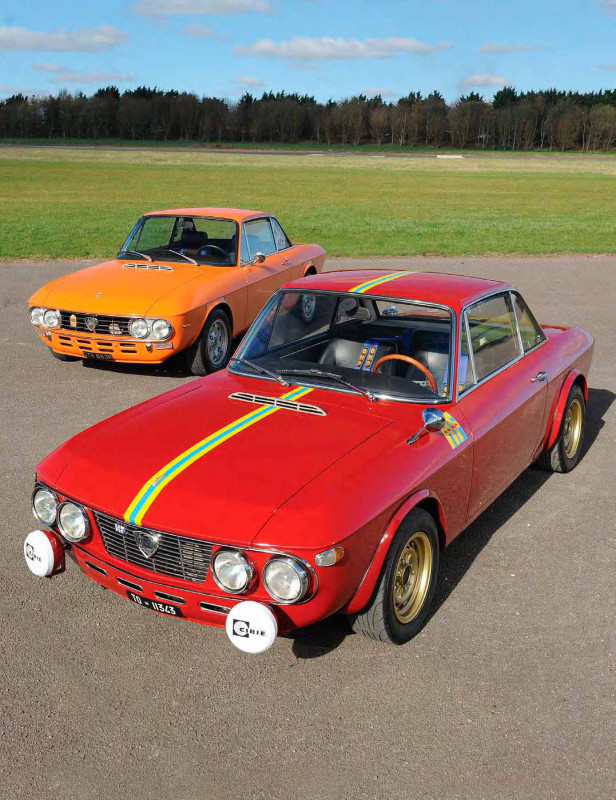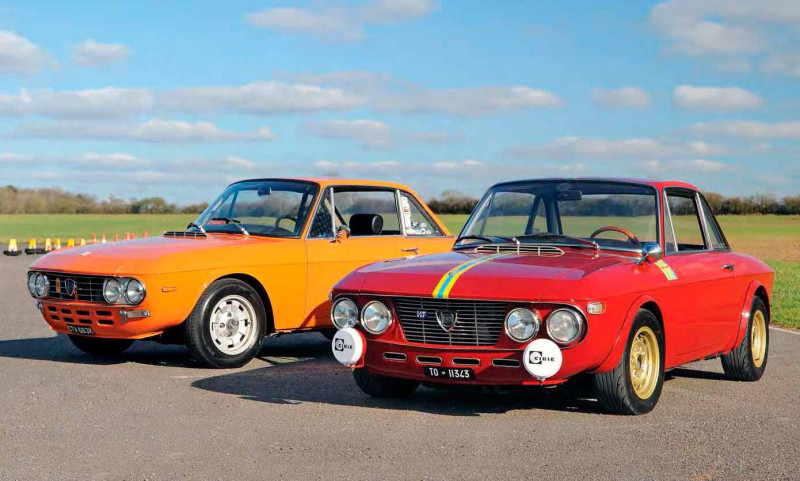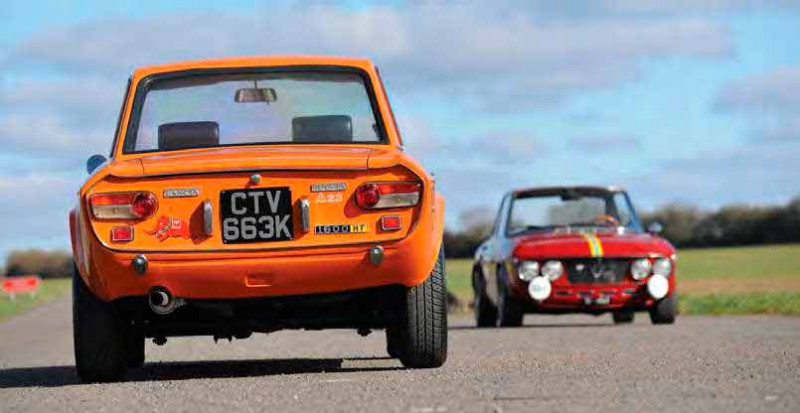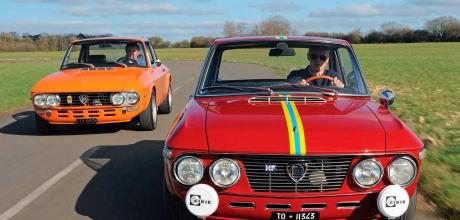1971 Lancia Fulvia Rallye HF 1.3 and 1600 HF back to back
After driving two ultra-rare HFs – 1300 and 1600 – with uprated engines, we’re left utterly smitten by Lancia’s enchanting Fulvia coupe. Story by Richard Aucock. Images by Michael Ward.
FULVIA HF RALLY STARS
LANCIA FULVIA TWIN TEST
1300 HF and 1600 HF back to back
My breath has been taken away. I was expecting Tony Rosewell to give me a gentle tootle in his precious Lancia Fulvia, to show me its peculiarities and get me up to speed. What he’s actually doing is roaring vigorously out of our airfield test area, using all the revs, running meticulously through the gears and showcasing the wonderful V4’s blare and the car’s blissfully garrulous nature. And then, after 10 minutes of thrills, it’s my turn. So that’s how you drive a Fulvia? Let me at it!

Earlier, Tony had already amazed me with the story of how he came to own his 1968 Fulvia 1300 HF. “Series 1 1600 HFs are the ones in demand,” he said. “People just don’t know about the 1300 HF.” Tony does, though, and it’s a love affair that goes right back to when he was 17 years old and a trainee at Lancia specialist, Nigel Hargreaves of HF Automotive in High Wycombe. For five years, he worked on Fulvias almost daily. Their spirit infused him, particularly his favourite: the 1300 HF.

After a career outside automotive, Tony has rekindled his professional interest in Lancias. He now travels to Italy frequently, sourcing enviable Fulvias and bringing them back to the UK for sale through Fulvia Classics. “I fly out and always drive back: it’s generally pretty painless and I always love the miles behind the wheel.” Talk about commitment. It was being conscious of taking precautions so as not to get stuck en route back to the UK that actually saw Tony end up with this 1300 HF.
His contact in Italy, Giorgio, owned a Fulvia as part of his collection, as did Giorgio’s pal, Francesco. They used to go out on drives together – spirited drives too, it seems, given the choice modifications made to their cars over the years. But then, sadly, Francesco got ill and could no longer drive his beloved cars. Giorgio vowed to find them a good home, so Francesco would know his cars were in safe hands.

Enter Tony. “I actually went out to look at another car,” he explains, “but when I saw it, I wasn’t keen. It wasn’t quite what I wanted, and seemed a bit tired. I was uncertain whether it would get me back to the UK, and didn’t fill me with confidence.”
After a bit of chatter in Italian, Tony discovered that there was another car he might like to see. In an underground car park, the lights flicked on and under an aged blanket a secret car was hidden. When the blanket came off, Tony gasped. It was a 1300 HF, one of just 882 built. “I couldn’t believe it. The car I’ve always wanted. Even better, it seemed in lovely condition, much better than the one I’d flown over to buy. I asked if it was genuine. ‘Of course it’s genuine!’ came the reply.”
Tony bought it on the spot and, the next day, was on his way back to the UK. “It was a brilliant drive. I was over the moon. And talk about luck – if I’d have gone with the other car, I might not have even known about this one. I’d waited 40 years to get 1 1300 HF and how it all came to be was a bit of a dream in itself.”
Back in the UK, he got to work with a full recommissioning and health check. What did he have? Not just any old 1300 HF, but one with a Claudio Maglioli engine. Yes, that Maglioli, the Lancia test genius and allround motorsport star who, in the early 1970s, retired from racing to concentrate on his own engine shop. He and his engineers took Tony’s car from its stock 101hp to around 115-120hp, thanks to thorough and careful honing, including 1600-spec Solex 42 side-draft carbs.
It has the optional extended wheelarches, and Campagnola wheels instead of the standard steel white wheels – made from magnesium, rather than aluminium. The HF has no bumpers, uses lightweight aluminium panels, an oil cooler and boasts a fuel filler for the tank in the boot. “It came as a bare car,” says Tony. “You bought it, often from a regular Lancia dealer, then took it to your race team to fit a roll cage, bigger fuel tanks and so on.”
Tony also points out the original Perspex rear screen and side windows, the straps instead of door handles and the lightweight seats. Weight? A scant 825kg. Then there’s the Amaretto colour, reserved only for the HF, and the famous hand-painted stripes in the colours of the city of Turin. “The steering wheel is pretty special too: it’s an original Hellebore, as fitted to the Alfa Romeo GTA.”
George Cedrickson has been listening intently. He owns the hyper-perfect 1972 1600 HF Corsa in Giallo that’s been luring the insects away from Tony’s car. George is new to the world of Lancia, and this is actually the first time he’s properly driven his car. Having bought it, lockdown happened, and George sensibly left it with Tony. “Tony’s been giving me lessons today,” he grins. I’d soon join the club, George.
George’s’ 1600 HF is, as you can see from the images, sublime, but it too is not standard. It’s not a Lusso, explains Tony, but an HF Corsa, of which Lancia made only 414. Key differences include aluminium doors, boot and bonnet plus, again, a Plexiglas rear screen and windows. Even the chrome surrounds for the front and rear screens were removed in the interests of saving weight – as were the door armrests and ‘door open’ warning lights. Oh, and the front quarter lights no longer opened.
Beneath that aluminium bonnet lies a very special 1.6-litre V4. Fully rebuilt, its tantalising spec includes twin Weber 45s, gas-flowed head, CPS pistons, fast-road performance cams, balanced crank and rods, and a balanced and lightened flywheel. There’s a full Group 4 exhaust, including the manifold, and an enlarged (and, Tony tells me, very rare) ‘Fanalone’ magnesium sump. Oh, and it runs electronic ignition. “I’ve still got all the original bits,” adds George. “They came boxed with the car.”
It’s a lovely car that sits perfectly on the road, helped by the flared wheelarches that were now built into the bodywork, rather than the extensions of Tony’s Series 1 HF. Inside, there are a few more clues to its rally-road past – the flexi-bend map reading light, the manually-adjustable red line on the Veglia tacho – and I also note the certification plates from the ACI and ASI: it’s certified as the real deal (Tony confirms it is Lancia Storico authenticated too).
Coffees finished, it’s photo shoot time. I follow Tony’s car, marvelling at how low, wide and tiny It looks, ogling the stripes, thinking how good the licence plates look (a trick some of you may already know: they’re Northern Ireland plates made up with an Italian look). During the shoot, I fill up my iPhone with shots of the two, waiting for Michael’s green light.
And then it comes. And that’s where I got the most intense driving lesson I’ve ever had, before we swapped seats. At last, I’m let at it. The Hellebore steering wheel feels wonderful, the dashboard looks beautiful; I note the cranked-around rev counter, dip the clutch and pop the wand-like gearlever into first (naturally it snicks in cleanly and mechanically).
It’s heaven. The rasp of that immeasurably free-revving V4 is divine, and its super-smooth nature has me hooked right away. A revvy, effervescent dream that I am soon, with encouragement from Tony, revving right through. It rolls along with such pliancy, such lack of hesitancy; it is brilliantly direct and confident, yet light and tactile with it. I hold the Hellebore with my fingertips, snick the gears in with a wand-like lightness of touch. It is a car to caress and revel in its fluidity and feedback, flowing so well I just want to drive and drive. Rarely have I bonded so immediately with a car, on such a spirited drive. I now understand Tony’s 40-year love affair.
But there’s more: George’s car is lined up for a blast. Again, time for a driving lesson with Tony, so I drop myself into the Fusina passenger seat and, as the olio dial on my side of the dash is showing it’s up to temp, brace myself for a blast. After explaining the lumpy idle of the mild race-rally cams, Tony muses that this engine is probably up from a stock 115hp to around 130hp, then eases the ZF five-speed back-left into first and sprints away.
It’s just five minutes of hyperdrive this time before Tony cheerily pulls over. “You know what you’re doing – have a go.” I think that’s what he said: my ears were still tingling from the trademark glorious roar of the Webers, a sound that’s sent from gods above.
Although the gearchange is tighter, it takes acclimatisation, due to the dog-leg, while the Ferrero steering wheel makes it feel more focused than Tony’s earlier car. The grippiness of the leather is welcome, as the steering itself is heavier, although it’s still brilliantly positive and direct. With the obvious extra performance, the meatier setup seems well judged.
Now I’m a Fulvia obsessive. Because George’s car exudes all the confidence of Tony’s, just with that bit more potency, I have the most glorious fast-road drive, revelling in its positivity and imperious cleanliness. Because it’s so tiny, and you therefore have so much road to play with, corners become rally-style: just turn in and get on the power, feeling the front-wheel drive traction, deepening the rasp and the roar, safe in the knowledge that if anything untoward happens, the car will tell you way in advance. If only modern cars could offer this clarity.
As a final treat, Tony instructs me to carry speed into the final corner, go in hard, then give it a bootful. I do so and the car responds by diving in, and we’re both limpetlike at the apex then rortily blaring out of it in a flash, rally-style. Thing is, it’s right in front of George. I roll towards him, waiting to see his reaction. Phew. He’s beaming, almost as broadly as I am. You’ve converted another to the Fulvia cause today, Tony: consider it a job well done.
Which would I have? Impossible. They’re both divine. George’s car is absolutely immaculate, a joy to behold and to drive. Tony’s car is tactile and rare – a wonderfully undiscovered collectable. Give me either. In fact, give me any Fulvia. These two best-of-breed cars are enough to convert anyone to the cause, and I later reflect how lucky I am to have driven them. Drive a Fulvia, any Fulvia, yourself. I promise it’ll take your breath away, too.
Contact: Fulvia Classics, Princes Risborough, 07831 109843, fulviaclassics com
1971 Lancia Fulvia Rallye HF 1.3
Est Value: £45,000
Based on 52 year old male, Architect, full NCB, living in NR6 postcode, SD&P (exc. commuting), garaged, 5000 miles pa, car club member, 2nd car for everyday use.
Premium: £133.10 inc IPT
Excess: £400 (exc. fee + legal cover)
Striking Giallo paint adorns 1600 HF. Both cars have many lightweight features such as Plexiglas screens. Ultra-rare 1300 HF has Claudio Maglioli-tuned engine with circa 120hp and drives superly sweetly


